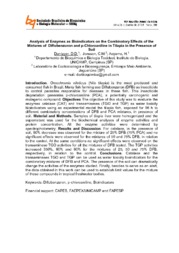Analysis of enzymes as bioindicators on the combinatory effects of the mixtures of diflubenzuron and p-chloroaniline in tilapia in the presence of soil.
Analysis of enzymes as bioindicators on the combinatory effects of the mixtures of diflubenzuron and p-chloroaniline in tilapia in the presence of soil.
Author(s): DANTZGER, D. D.; JONSSON, C. M.; AOYAMA, H.
Summary: Introduction. Oreochromis niloticus (Nile tilapia) is the most produced and consumed fish in Brazil. Many fish farming use Diflubenzuron (DFB) as insecticide to control parasites responsible for diseases in these fish. This insecticide degradation generates p-chloroaniline (PCA), a potentially carcinogenic and mutagenic compound. Objectives The objective of this study was to evaluate the enzymes catalase (CAT) and transaminases (TGO and TGP) as water toxicity bioindicators using as experimental model the tilapia fish, exposed for 96 h to different combinatory concentrations of DFB and PCA mixtures, in presence of soil. Material and Methods. Samples of tilapia liver were homogenized and the supernatant was used for the biochemical analyses of enzyme activities and protein concentration. All the enzyme activities were determined by spectrophotometry. Results and Discussion. For catalase, in the presence of soil, 80% decrease was observed for the mixture of 25% DFB (75% PCA) and no significant effects were observed for the mixtures of 50 and 75% DFB, in relation to the control. At the same conditions no significant effects were observed on the transaminase TGO activities for all the mixtures of DFB tested. The TGP activities increased 350%, 80% and 60% for the mixtures of 25, 50 and 75% DFB, respectively, in relation to the control. Conclusions. Catalase and the transaminases TGO and TGP can be used as water toxicity bioindicators for the combinatory mixtures of DFB and PCA. The presence of the soil can dramatically change the activities of the enzymes studied. Finally, besides to serve as an alert, the data obtained in this work can be used to establish limit values for the mixture of these compounds in tropical freshwater bodies.
Publication year: 2016
Types of publication: Abstract in annals or event proceedings
Unit: Embrapa Environment
Keywords: Bioindicators, Diflubenzuron, Enzima, P-chloroaniline
Observation
Some of Embrapa's publications are published as ePub files. To read them, use or download one of the following free software options to your computer or mobile device. Android: Google Play Books; IOS: iBooks; Windows and Linux: Calibre.
Access other publications
Access the Agricultural Research Database (BDPA) to consult Embrapa's full library collection and records.
Visit Embrapa Bookstore to purchase books and other publications sold by Embrapa.

